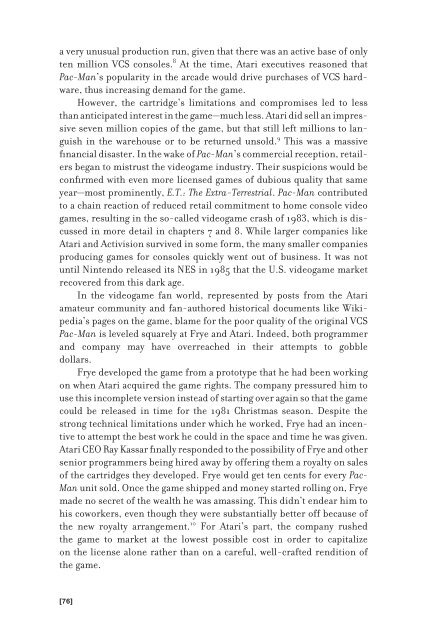Racing the Beam : the Atari Video Computer System - Index of
Racing the Beam : the Atari Video Computer System - Index of
Racing the Beam : the Atari Video Computer System - Index of
You also want an ePaper? Increase the reach of your titles
YUMPU automatically turns print PDFs into web optimized ePapers that Google loves.
a very unusual production run, given that <strong>the</strong>re was an active base <strong>of</strong> only<br />
ten million VCS consoles. 8 At <strong>the</strong> time, <strong>Atari</strong> executives reasoned that<br />
Pac-Man’s popularity in <strong>the</strong> arcade would drive purchases <strong>of</strong> VCS hardware,<br />
thus increasing demand for <strong>the</strong> game.<br />
However, <strong>the</strong> cartridge’s limitations and compromises led to less<br />
than anticipated interest in <strong>the</strong> game—much less. <strong>Atari</strong> did sell an impressive<br />
seven million copies <strong>of</strong> <strong>the</strong> game, but that still left millions to languish<br />
in <strong>the</strong> warehouse or to be returned unsold. 9 This was a massive<br />
fi nancial disaster. In <strong>the</strong> wake <strong>of</strong> Pac-Man’s commercial reception, retailers<br />
began to mistrust <strong>the</strong> videogame industry. Their suspicions would be<br />
confi rmed with even more licensed games <strong>of</strong> dubious quality that same<br />
year—most prominently, E.T.: The Extra-Terrestrial. Pac-Man contributed<br />
to a chain reaction <strong>of</strong> reduced retail commitment to home console video<br />
games, resulting in <strong>the</strong> so-called videogame crash <strong>of</strong> 1983, which is discussed<br />
in more detail in chapters 7 and 8. While larger companies like<br />
<strong>Atari</strong> and Activision survived in some form, <strong>the</strong> many smaller companies<br />
producing games for consoles quickly went out <strong>of</strong> business. It was not<br />
until Nintendo released its NES in 1985 that <strong>the</strong> U.S. videogame market<br />
recovered from this dark age.<br />
In <strong>the</strong> videogame fan world, represented by posts from <strong>the</strong> <strong>Atari</strong><br />
amateur community and fan-authored historical documents like Wikipedia’s<br />
pages on <strong>the</strong> game, blame for <strong>the</strong> poor quality <strong>of</strong> <strong>the</strong> original VCS<br />
Pac-Man is leveled squarely at Frye and <strong>Atari</strong>. Indeed, both programmer<br />
and company may have overreached in <strong>the</strong>ir attempts to gobble<br />
dollars.<br />
Frye developed <strong>the</strong> game from a prototype that he had been working<br />
on when <strong>Atari</strong> acquired <strong>the</strong> game rights. The company pressured him to<br />
use this incomplete version instead <strong>of</strong> starting over again so that <strong>the</strong> game<br />
could be released in time for <strong>the</strong> 1981 Christmas season. Despite <strong>the</strong><br />
strong technical limitations under which he worked, Frye had an incentive<br />
to attempt <strong>the</strong> best work he could in <strong>the</strong> space and time he was given.<br />
<strong>Atari</strong> CEO Ray Kassar fi nally responded to <strong>the</strong> possibility <strong>of</strong> Frye and o<strong>the</strong>r<br />
senior programmers being hired away by <strong>of</strong>fering <strong>the</strong>m a royalty on sales<br />
<strong>of</strong> <strong>the</strong> cartridges <strong>the</strong>y developed. Frye would get ten cents for every Pac-<br />
Man unit sold. Once <strong>the</strong> game shipped and money started rolling on, Frye<br />
made no secret <strong>of</strong> <strong>the</strong> wealth he was amassing. This didn’t endear him to<br />
his coworkers, even though <strong>the</strong>y were substantially better <strong>of</strong>f because <strong>of</strong><br />
<strong>the</strong> new royalty arrangement. 10 For <strong>Atari</strong>’s part, <strong>the</strong> company rushed<br />
<strong>the</strong> game to market at <strong>the</strong> lowest possible cost in order to capitalize<br />
on <strong>the</strong> license alone ra<strong>the</strong>r than on a careful, well-crafted rendition <strong>of</strong><br />
<strong>the</strong> game.<br />
[76]


